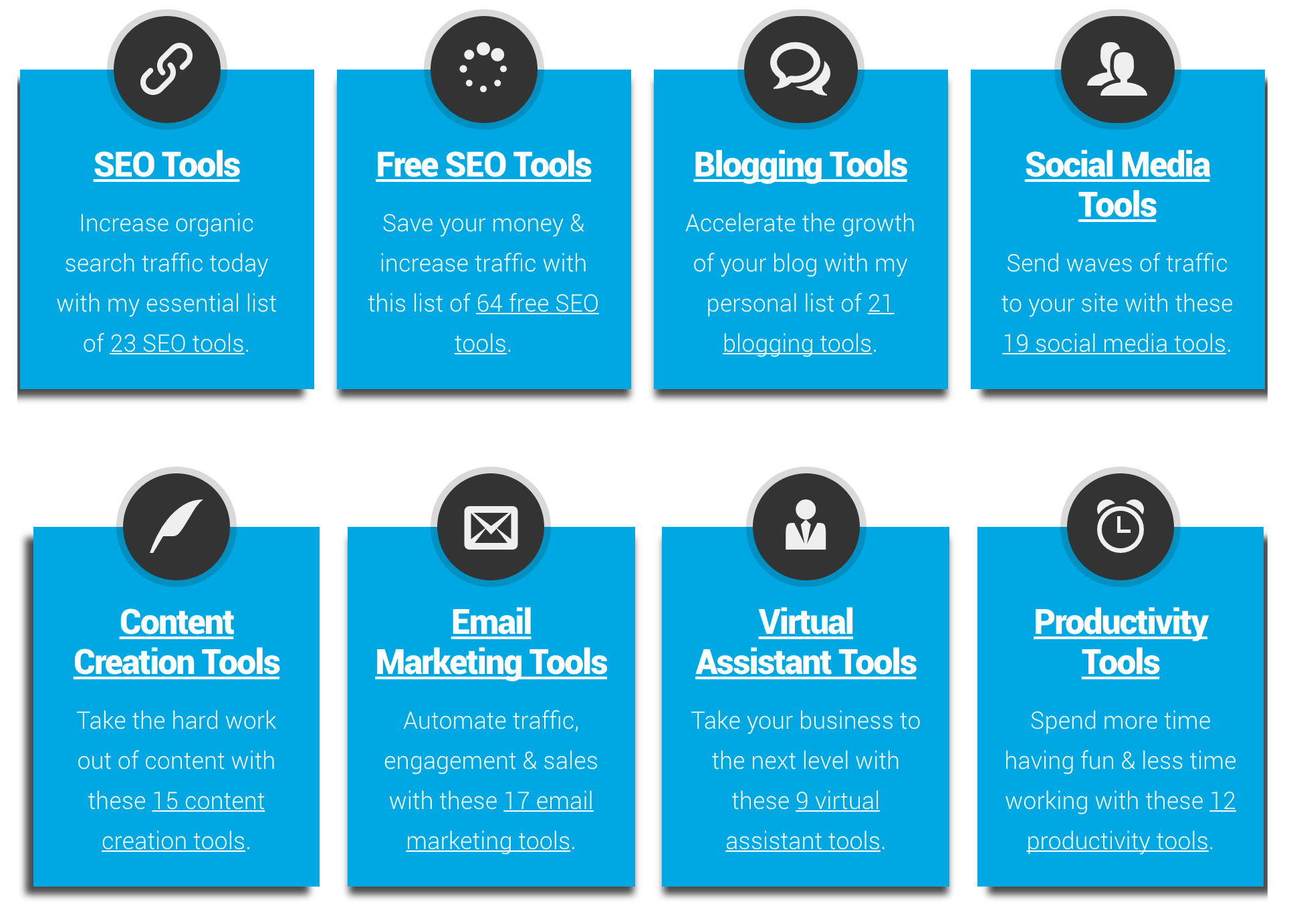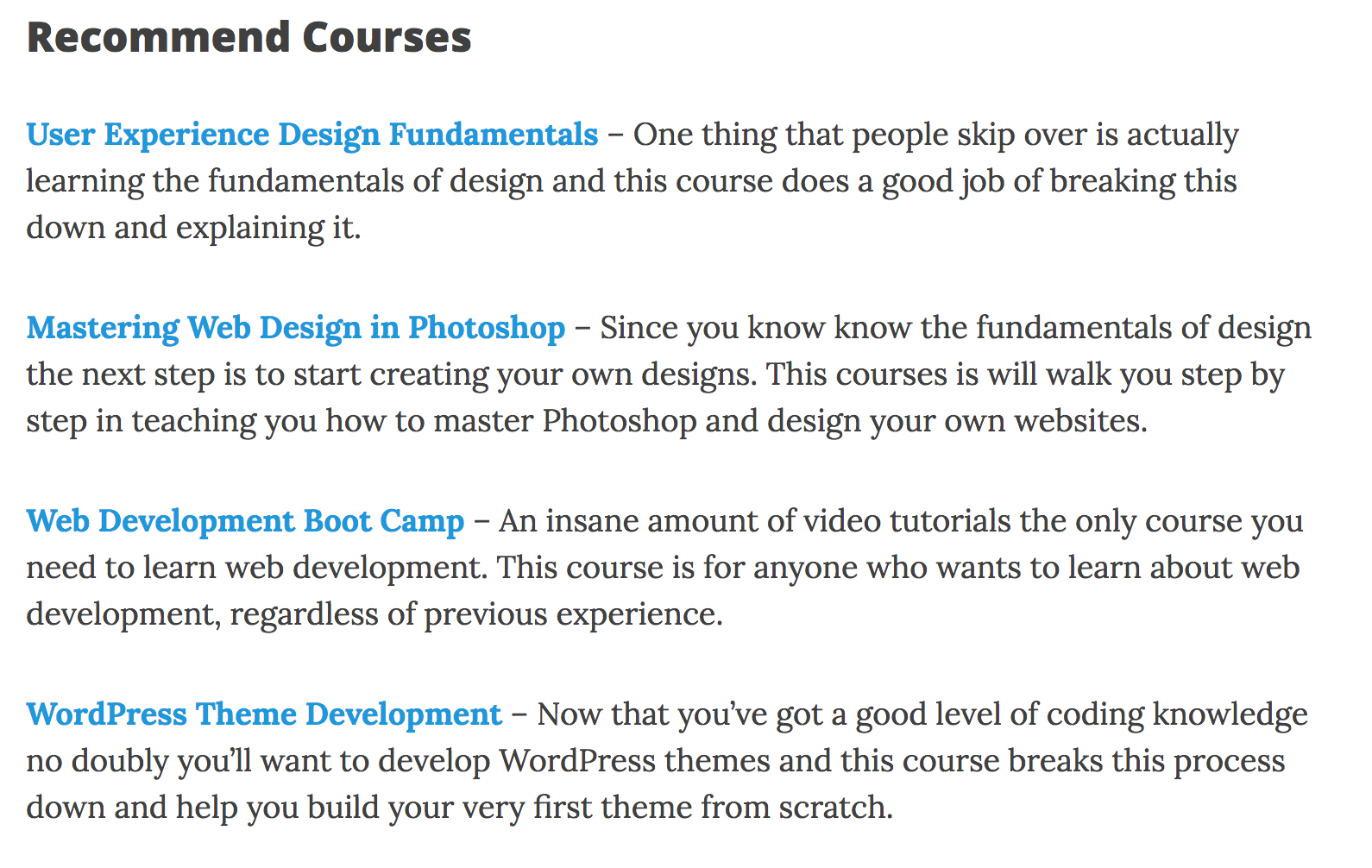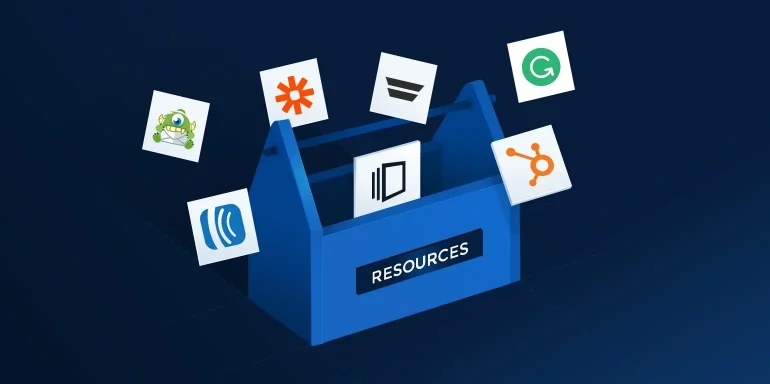A resource guide will help your audience while delivering you a steady stream of profits over time. It is also incredibly easy and fast to create.
What is a resource guide?
A resource guide is a list of the business solutions you recommend with a short description on what they are, how you are using them in your business, and why your audience will benefit from using them. You then link to each solution, using your affiliate link where you can to earn commissions.
The resources you include can be free solutions, like WordPress, or paid solutions like Instapage. They can range from software and web hosting, to books, trainings, and conferences you recommend. The only requirement is your recommendations benefit your audience.
Your resource guide should be built for your audience. If you’re addressing those in real estate, for example, recommend solutions that will benefit professionals in that industry. Creating a distinct, industry-specific list will better serve your audience, and will set you apart from the many others who have created resource guides. (Of course, there will be solutions, like Instapage, that are used across multiple industries and these should be included too.)
How to structure your resource guide
There are elements you want to include in your resource guide. Here’s what to include:
1. Position yourself as an authority
At the start, establish yourself as an authority. By demonstrating that you are singularly well-suited to create a resource guide, you immediately allay your reader’s worries about your credibility. Then explain that you created your guide as the best, and easiest way to share the solutions that work well for you.
Charles Ngo executes this perfectly at the beginning of his resource guide
“I’ve been in affiliate marketing since 2008 (here’s the series on how I made my first $1m). Forget wasting years of time and thousands of dollars – I wanna show you how I personally did it, and how I stay at the top of this industry year in, year out.”
His stated longevity and consistent success in the industry immediately appeal to any reader. His warning that you could waste a lot of time and money also motivate the reader to follow his advice and recommendations.
2. Use a disclaimer
It’s important to be upfront with your audience. Let them know you may be earning an affiliate commission on some of the solutions you are recommending but emphasize you are recommending these solutions because you have found them to be valuable and not because you are being paid to recommend them.
For instance, Abby Lawson, author of Just a Girl and Her Blog, discloses at the opening of her resource guide: “This post contains affiliate links. For more information, see my disclosure here.”
Abby uses her disclaimer disclosure to build trust with the reader by explaining why affiliate links are included throughout her website and that she would not compromise the integrity of her brand just to earn affiliate commissions.
3. Categorize your recommendations
Next, make it easy for visitors to find what they’re looking for by categorizing all of your recommendations. Is it a set of recommendations for web hosting? Search engine optimization? Invoicing? The categories will vary by industry but help your visitors by sorting the solutions. Create headings for the categories and list the corresponding resources under each category.
Blogger and SEO agency owner Matthew Woodward recommends a lot of tools in the resource section of his website – 116 and counting. To help visitors easily find solutions pertinent to their business, he categorizes the tools into email marketing, blogging, and productivity. Then he gives each category its own dedicated page.

Given the number of tools Matthew Woodward recommends, it’s a wise decision to give each category a dedicated page. If you’re only making a couple recommendations in each category though, it would be overkill and inefficient to create a separate page.
4. Explain your recommendations
Once you’ve created your list of solutions and categorized them, give a succinct but informative explanation about what each solution does and why you’re recommending it. Don’t just tell visitors what it is. Explain the value it will bring to their business. Will the solution bring more leads? Will it save them time? Will it give them new insights into their visitors or customers?
If the solution is free, it’s good to clarify that in your commentary. If not, it’s not necessary to give details on the pricing. Let the company you’re recommending share those details, and trust in their marketing team to present and sell their product. If there’s a version or specific plan you recommend, you can share that.
Remember, you want your explanations to be succinct. If you’ve written a review or have more to say then provide a link to a blog post where that resource has been covered in more depth.
Take a look at how Rae Hoffman, CEO of digital marketing agency PushFire, explains recommendations on her affiliate marketing blog Sugarrae:

Her recommendation descriptions for keyword research tools are short and to the point. When more details are warranted, she links to the tutorial she created for SEMrush and the full review she wrote for SpyFu.
There may be cases where competing solutions are available. While it’s not advisable to list every available solution, you can recommend more than one. Lead with the solution that best met your needs. Then suggest the alternative that may better meet the needs of other readers.
5. Use your affiliate links
Once you’ve listed, categorized, and explained all of your recommendations, link to each using an affiliate link where you can. Some of the solutions you’re recommending will be free and not all will have affiliate programs. That’s okay. Your goal should be to provide value to your audience while monetizing the solutions you can.
How to deliver your resource guide
You can deliver your resource guide in a couple different formats. When deciding upon the format, consider your goals and which format you believe your audience will respond to best.
One way of delivering a resource guide is by creating a standalone page on your website – often referred to as a resource page.
Take this example from Despreneur, an academy and community for entrepreneurial designers. With recommendations on design courses and tools for blogging and web and development, their resource page provides a comprehensive list of resources that will help designers get off to a great start. Each recommendation is categorized and explained, allowing the visitor to determine which tools may be of help. In this case, chronologically listing the course recommendations based on experience is also thoughtful and helpful.

Another way to deliver your resource guide is by leveraging it as a lead magnet. Visitors would only be given access in exchange for their contact information. This approach presents more friction than a standalone web page so it needs to deliver plenty of value.
Freedym developed a resource guide featuring must-have “freemium” tools. Rather than directly monetizing the resource guide with affiliate links, it chose to gate the resource guide as a download accessible only after the visitor provided their contact information. Freedym is using their resource guide to build their email list (a.k.a. lead magnet), theoretically driving future revenue.

Using your resource guide as a lead magnet presents as a very attractive option – you build your list while earning affiliate commissions – but it will not work in all cases. It’s important to match your approach with your audience.
Update your resource guide
Keeping your resource guides up-to-date is vital to growing your conversions, and commissions. Why? Two reasons. The first is, by staying current with your guides you further demonstrate that you are engaged and always on the look out for the best products to recommend. This is a powerful influence building practice.
Second (and as important), as your business grows the number of solutions you will want to recommend will grow, too. For example, four months ago, you may not have been using a landing page platform, or the landing page platform you were recommending four months ago may not be your preferred choice anymore. It’s up to you to convey to your audience that you’re always updating, upgrading, and improving. Keeping your resource guide relevant to your business use and your audience’s needs will yield far greater returns.
It will also be worth checking back with companies that did not offer an affiliate or referral program when you first published your resource guide. They could add one at any time, enabling you to further monetize your resource guide.
Go above and beyond
Based purely on the the potential return your resource guide can generate, it’s worth the extra effort to drive more traffic to increase the potential for conversions. Here are three simple strategies to achieve this:
1. Add live chat
Live chat can be a smart investment with the potential to drive more conversions and affiliate commissions. For example, Fire Up Your Online Business took a creative approach by adding live chat to their resource page and offering to answer questions about the solutions they’re recommending:

A recent survey conducted by emarketer.com survey reported that 38% of respondents made their purchase due to a live chat session.
2. Boost traffic with help from your visitors
If you’re delivering your resource guide via a web page, make it easy and ask visitors to share it on social media using tools like ClickToTweet. Or, inspire visitors to forward it via email with this short message: “Know someone who will benefit from these resources? Email it to them today.”
3. Encourage bookmarks to keep visitors coming back
Present your resource guide as an ever-handy tool visitors should regularly reference. If you’re delivering your resource guide via a web page, encourage them to bookmark it. This will keep visitors returning and potentially converting, earning you more in affiliate commissions.
Create and start leveraging a resource guide
Create a resource guide to deliver value to your website visitors without expending a ton of time and effort. Deliver the most to your visitors and gain the most for yourself by following these principles:
- Tailor it to your audience
- Structure your resource guide so that it is easy to navigate and succinctly helpful
- Include affiliate links to bring additional passive income stream into your business
Don’t forget to include Instapage on your list of your resources. If you’re not one of our affiliate partners yet, join us and start recommending Instapage as the best landing page solution.

Try the world's most advanced landing page platform with a risk-free trial.
